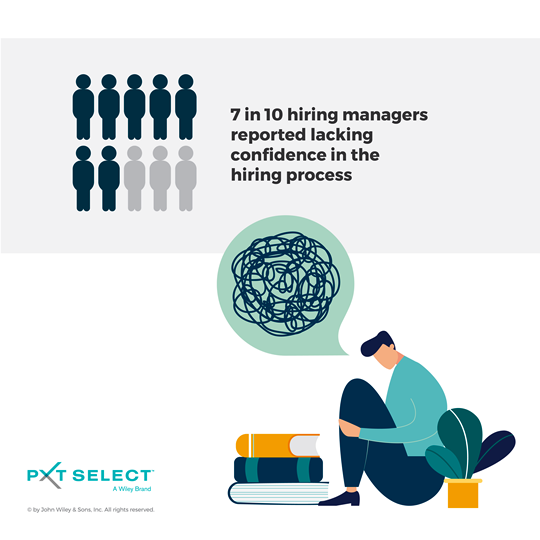Workplace innovation starts with hiring the right people

Workplace innovation is more than a steady flow of creativity; it requires continual evolution, and the understanding that the first idea that comes along—even if it comes from the Boss—isn’t always the best. If you want to build an innovative workplace, consider the following suggestions.
Hire the right people
The work you're doing today is probably quite different from the work done by the person in your job five years ago—if there was one. Innovation affects us all whether we're initiating the innovations or not.
The job of hiring managers, for example, now includes technologies, tools, expectations, and workforce needs not seen years or even months ago.
Hiring people for their innovative capabilities is now a common objective at many organizations. But these people can be difficult to spot quickly without knowing the person’s complete profile. Employee assessments like PXT Select™ can help employers select candidates who show innovative thinking abilities and naturally creative behaviors, not just the experience and education to do the job as it is.
Innovators are often seen as having traits like these: a willingness to try new things, excitement for new challenges, a tolerance for ambiguity, a passion for learning, an expressive nature, a natural curiosity, and an eclectic way of thinking. Assessments can help you identify these traits quickly.
Building diversity into your workforce in terms of backgrounds, experiences, personalities, and interests can improve your teams' ability to look at the way you do things from a wide variety of perspectives.
Hiring innovative thinkers requires innovative recruitment tactics, as well. When was the last time you reviewed and re-evaluated your recruiting methods and interview practices?
- Are you trying new methods of recruitment?
- Could you improve how you communicate the benefits of working for your organization?
- Have you educated your staff on how to be better ambassadors for your organization?
- Are you effectively using pre-hire assessments?
- Do your managers understand how to interview candidates effectively?
- In short, are your recruitment and hiring tactics attractive to innovators, and do they help you spot people with innovative thinking styles?
“If you don’t have the right people in the right places—the right talent strategy, the right team dynamics, the right culture—and if you don’t proactively manage how an organization works from a culture and a people perspective, you’re on a serious path to disaster.”
-- Ellie Filler, senior client partner, Korn Ferry, Why Chief Human Resource Officers Make Great CEOs, Harvard Business Review
A structured process for innovation
Structure is not the enemy of workplace innovation, as many people think. Instead, structure provides a thought process by which one can measure tangible results. Without a problem, there can be no creative solutions, and structure provides the scaffolding for reaching and attacking the problem.
Scott Jewett, CEO and founder of Element-Y, has described four steps to find innovation in the workplace: Define the essence of the problem. Embrace constraints. Generate, quick-test and select ideas. And execute.
"You must do steps 1 and 2 before you start having idea fun in step 3," he says. "Step 3 is iterative, and only when you emerge victorious from step 3 do you move on to execution. Most companies merely set an innovation intention and fund the process. Teaching their natural innovators this simple, structured process can help yield great innovation returns, and often transform the competitive landscape."
How do create an environment that encourages innovation?
- Nurture, recognize and reward innovative thinking.
- Provide opportunities to collaborate across teams.
- Create a culture of continuous learning and experimentation.
- Allow for risk-taking and failures.
- Sustain a safe environment where employees can challenge each other, their leaders and the status quo without fear of reprisal.
Stay focused on the big picture
Sometimes companies get so wrapped up in the solutions stemming from the need for innovation that they lose sight of the bigger picture. Innovation doesn’t have to mean major breakthroughs; far more common are innovating the small steps and details. Either way, innovation needs to support the organization's vision and mission. A compelling vision can be inspirational and motivating for innovators and provide the structure for their thinking and ideas.
Organizations must also be prepared for the transformation or disruption that innovation can bring. Adopting innovative ideas can make people uncomfortable. People can lose their jobs or be forced to learn new techniques and work with new tools. Too much change too fast can confuse your employees and your customers. Yet too little change can result in stagnation.
Think about your phone. Do you really enjoy having to relearn functions every time you get a new one? Do you investigate or want each new option? But do you want to go back to a standard flip-phone? Microsoft's Kin phone was innovative, but have you even heard of it?
Having a team of only innovators is not the solution, either. It can hinder the basic delivery of core products and services.
Some organizations find success through the trust developed over a long history of sustained performance that shouldn't be disrupted too quickly. Innovation can create conflict and come from conflict. But it must be managed, and keeping all eyes on the goal facilitates this.
Innovators can help create a positive and exciting work culture, help improve your company's position in a competitive market, open new markets, and contribute to the elimination of waste and unnecessary costs.
But organizations also need people to maintain infrastructure, ensure compliance, sustain relationships with customers and vendors, and deliver products and services. So knowing when and how to hire innovators is a crucial HR ability.
A version of this article first appeared on Profiles International's website.


